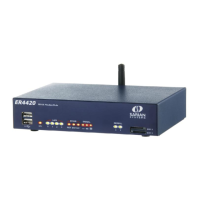Configure serial interfaces
Digi TransPort User Guide 270
Advanced Serial Port parameters
The configuration parameters in this section are changed less frequently than those in the basic
section and so are given a separate page in order to reduce screen clutter.
Answer V.120 calls after n rings (0 = Don’t answer)
Controls the answering of incoming V.120 calls. When set to zero, V.120 answering is disabled,
otherwise V.120 answering is enabled on this interface. Enter the number of rings to wait
before answering the call into this text box. This is equivalent to setting the value of the S0
register for the associated serial port.
DCD
Selects how the Data Carrier Detect (DCD) signal is controlled. The available options are:
•Auto: Configures the router so that it will only assert the DCD line when an ISDN
connection has been established; this is equivalent to AT&C1.
•On: Configures the router such that the DCD line is always asserted when the router is
powered-up; this is equivalent to AT&C0.
•Off: Configures the router such that the DCD line is normally asserted but is de-asserted
for the time period specified by the S10 register after a call is disconnected; this is
equivalent to AT&C2.
•Pulse Low
DTR Control
This drop-down selection box controls how the router responds to the DTR signal. The
available options are:
•None: Configures the router to ignore the DTR signal; this is equivalent to AT&D0.
• Drop call: Configures the router to disconnect the current call and return to AT command
mode when the DTR signal from the attached terminal (DTE) is de-asserted; this is
equivalent to AT&D1.
• Drop line and call: Configures the router to disconnect the current call, drop the line and
return to AT command mode when the DTR signal is de-asserted; this is equivalent to
AT&D2.
• Drop call on transition
• Drop line and call on transition
DTR de-bounce time s x 20 milliseconds
The length of time (in multiples of 20ms) for which the DTR signal must be de-asserted before
the router acts on any options that are set to trigger on loss of this signal. Enter the desired
multiple into the text box. Increasing this value makes the router less sensitive to “bouncing”
of the DTR signal. Conversely, decreasing this value makes the router more sensitive. The
default of 100ms (5 times 20ms) is a reasonable value.
Escape Character
The character used in the escape sequence. The default is the + symbol (ASCII value 43, 0x2b).
Changing this value has the same effect as changing the S2 register.

